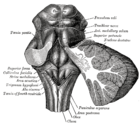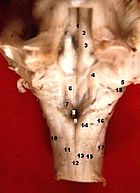Medial eminence of floor of fourth ventricle
| Medial eminence of floor of fourth ventricle | |
|---|---|
 Rhomboid fossa. (Medial eminence visible but not labeled.) | |
 Human caudal brainstem posterior view description (Eminentia medialis is #2) | |
| Details | |
| Identifiers | |
| Latin | eminentia medialis fossae rhomboideae |
| NeuroNames | 1922 |
| TA98 | A14.1.05.704 |
| FMA | 78479 |
| Anatomical terms of neuroanatomy | |
In the human brain, the rhomboid fossa is divided into symmetrical halves by a median sulcus which reaches from the upper to the lower angles of the fossa and is deeper below than above. On either side of this sulcus is an elevation, the medial eminence, bounded laterally by a sulcus, the sulcus limitans.[1]
In the superior part of the fossa the medial eminence has a width equal to that of the corresponding half of the fossa, but opposite the superior fovea it forms an elongated swelling, the colliculus facialis, which overlies the nucleus of the abducent nerve, and is, in part at least, produced by the internal genu of the facial nerve.
References[]
- ^ Levine, Seymour; Saltzman, Arthur; Ginsberg, Stephen D. (2011). "Vacuolar Pathology in the Median Eminence of the Hypothalamus Following Hyponatremia". Journal of Neuropathology and Experimental Neurology. 70 (2): 151–156. doi:10.1097/NEN.0b013e318208fc5d. PMC 3074179. PMID 21343884.
![]() This article incorporates text in the public domain from page 799 of the 20th edition of Gray's Anatomy (1918)
This article incorporates text in the public domain from page 799 of the 20th edition of Gray's Anatomy (1918)
External links[]
- Wikipedia articles incorporating text from the 20th edition of Gray's Anatomy (1918)
- Ventricular system
- Neuroscience stubs